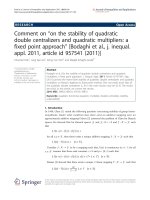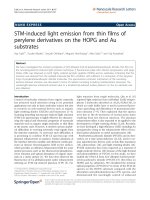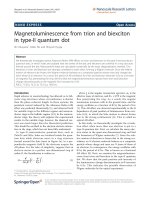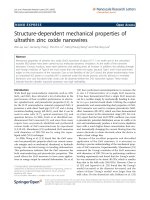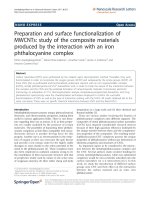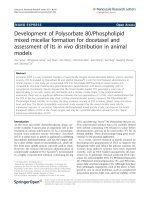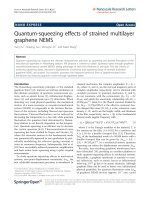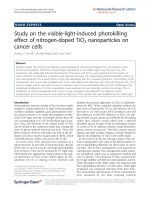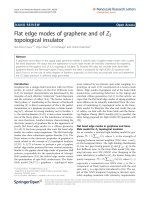Damm et al. Health Economics Review 2011, 1:16 pptx
Bạn đang xem bản rút gọn của tài liệu. Xem và tải ngay bản đầy đủ của tài liệu tại đây (180.83 KB, 6 trang )
RESEARCH Open Access
Promoting vaccinations - an analysis of measures
taken by German statutory health insurers
Kathrin Damm
*
, Jana M Schubert and J-Matthias von der Schulenburg
Abstract
Introduction: Prophylactic vaccinations play a significant role in health care. As a relatively cost-effective
preventive measure they can help to avert transmissible diseases and thus protect not only the vaccinated
individuals themselves but also those who have not been vaccinated. In order to achieve this, a high vaccination
rate is necessary; for many prophylactic vaccinations this rate is not reached in Germany. In order to counteract
this trend the importance of prophylactic vaccinations was upgraded in 2007 within the scope of the reform of
the health system. The reimbursement of patients’ vaccination fees was made compulsory for the statutory health
insurance companies and statutory requirements were imposed on the insurers to ensure a nationwide provision
of prophylactic vaccinations for insured persons. The objective of this paper is to evaluate to what extent the
health insurance companies promote the increasing of vaccination coverage rate today and what measures are
being used to present this topic to the public.
Methods: In order to assess the public presentation of the topic “prophylactic vaccinations” we have examined the
websites of 68 statutory health insurance companies. We have assessed the attitude of the companies towards the
promotion of participation in vaccination programs by conducting qualitative, structured interviews with
representatives of 8 health insurers.
Results: Measures to promote vaccinations, such as information, recall offers, projects to educate people or even
monetary incentives, are employed relatively extensively by the health insurers and are considered important.
However, it became clear that the discussion about prophylactic vaccinations, in particular concerning the costs
and benefits thereof, had not been completed yet within the companies. Vaccination-specific data is not collected
or evaluated on a regular or even isolated basis. There are no concrete targets concerning specific vaccination
rates and incentives are neither evaluated nor compared with one another.
Conclusions: The relatively extensive range of measures used to promote the vaccination rate contrasts with
insufficient knowledge about their efficacy and efficiency. There is an urgent requirement for more research here.
Keywords: Vaccination, vaccination rate, health insurance, incentives, promotional measures
Background
Prophylactic vaccinations play a significant role in healt h
care. As a relatively cost-effective preventive measure
they can help to avert transmissible diseases and t hus
protect not only the vaccinated individuals but also those
who have not been vaccinated, by containing the spread
of pathogenic agents [1,2]. In order to achieve this, a high
vaccination rate is necessary which, for many prophylac-
tic vaccinations, is not reached in Germany [3]. The
highest rates are amongst children, whose vaccinations
can be performed by a pediatrician as part of the regular
detection screenings, if parents agree. After childhood
this rate drops continuously. For example for diphtheria
and tetanus vaccination s the percentage of vacc inated
individuals drops from 80 percent in 18 year olds to
around 40 percent in 70-79 year olds [4,5].
In Germany vacci nations are usually administered on a
voluntary basis; however, the Federal Ministry of Health
can order prophylactic vaccinations when there is a dan-
ger of epidemics. Reasons for the low vaccination rates
are amongst others that infectious diseases are no longer
* Correspondence:
Centre for Health Economics, Leibniz University Hannover, Hannover,
Germany
Damm et al. Health Economics Review 2011, 1:16
/>© 2011 Damm et al; licensee Springer. This is an Open Access article distributed under the terms of the Creative Commons Attribution
License ( which permits unrestricted use, distribution, and reproduction in any medium,
provided the original work is properly cited.
perceived by the population as being a threat due to the
success of vaccinations in the past [1]. Further reasons
include a lack of information, the inadequate use of doc-
tor-patient contacts and the low importance of preven-
tive medicine [4,5]. At the same time firm convictions, a
lack of trust in medical procedures and religious beliefs
prevent people from participating in recommended pro-
phylactic vaccination schemes [6].
In 2007 the importance of prophylactic vaccinations
was upgraded in Germany. Once the Standing Vaccina-
tion Committee (STIKO), the major federal commission
concerned with vaccination issues in Germany, recom-
mends particular vaccinations, statutory health insurers
were forced to reimburse these.Thisdoesnotapplyto
travel or occupational vaccinations. Furthermore statu-
tory requirements were impo sed on the insurers to
ensure a nationwide provision of prophylactic vaccina-
tions for insured persons.
The objective of this paper is to evaluate to what
extent the statutory health insurers promote the
increase in vaccination rates and what measures are
being used to present this topic in public.
Methods
In order to assess the public presentation of the topic
“prophylactic vaccinations” we examined the websites of
68 statutory health insurers. We took into account pub-
licly accessible insurance companies with at least 100,000
insured. Activities of the healt h insurers which are sui ta-
ble for motivating insured persons to participate more in
prophylactic vaccination schemes were evaluated. The
data analysis was performed using the software SPSS.
In order to examine the general attitude of the health
insurers towards the statutory requirem ents we c on-
ducted structured interviews with representatives of eight
health insurers of different sizes. We selected representa-
tives who deal with the issue of vaccinations in their
companies, in most cases the head of the prevention divi-
sion. An initial contact has been made via telephone or
e-mail.
The questionnaire covered 5 different topics:
1. Possible reasons for the low vaccination rate
2. The situation before 2007:
a. What vaccinations were offered as optional
benefits?
b. What was the motivation behind this decision?
c. What was the demand from the insured persons
at the time?
d. What incentives were used to motivate the
insured persons?
3. The o pinion about the legislative amendment and
the introduction of prophylactic vaccinations as a
compulsory benefit of the insurance companies pursuant
to the German Social Code (§ 20 d SGB V)
4. The current situation after the legislative amend-
ment, as for point 2.
5. With regard to “controls":
a. Are vaccination rates recorded?
b. If so, do targets exist?
c. Do sickness funds use measures to increase vacci-
nation rates?
The interviews were actually conducted and recorded
by telephone, using internet telephony software ("Skype”
Voice over IP client, “Pamela” Call Recorder). The infor-
mation provided by the interviewees was evaluated with
software program MAXQDA, both deductive and induc-
tive [7,8].
Results
Analysis of websites
The68healthinsurersincludedinthisanalysisinsure
from 100,000 to more than 7 million individuals. Alto-
gether around 67 million persons are insured by these
68 companies. Because a total of approx. 70 million peo-
ple in Germany were insured in 202 statutory health
insurers in December 2009 [9], 95.7 percent of all these
persons are included in the 68 health insur ance compa-
nies evaluated in our study.
First we examined the way in which the topic of “pro-
phylactic vaccinations” was presented on the w ebsites of
the individual insurers. Only for two of the insurance
companies no information about prophylactic vaccina-
tions could be found on their websites (see Table 1). All
remaining insurers did provide information on their web-
sites. 22 of them presented the information about pro-
phylactic vaccinations which are included in the
insurance coverage in a neutral way and explained that it
is compulsory for statutory health insurers to meet the
cost of prophylactic vaccinations, while the remaining 46
insurers (which corresponds to 67.6 percent) used pro-
phylactic vaccinations as a marketing instrument to a
certain extent by emphasizing that they provided this
benefit.
In addition to the general information about the provi-
sion of prophylactic vaccinations 33 websites contained
further information about prophylactic vacc inations such
as vaccination guides with background information about
how prophylactic vaccinations work as well as their bene-
fits and risks. Nine websites also include at least some
information or references to specialised research facil-
ities. One of the websites provides additional information
in a special section for young parents.
The offer of a so-called “vaccination manager” which
provides information, includes a planning and reminder
Damm et al. Health Economics Review 2011, 1:16
/>Page 2 of 6
function and notifies the insured person registered for
this service by e-mail or mail about any upcoming vacci-
nations, also fits into this context. 22 of the 68 health
insurers offer this service in connection with a vaccina-
tion calendar which in turn recommends the optimum
times for prophylactic vaccinations or booster shots. A
similar vaccination calendar was also offered by addi-
tional 10 insurers. 34 health insurers did not offer any
comparable service.
Some health insurance companies also cover vaccina-
tions for private trips abroad, so-called travel vaccinations.
36 of the 68 insurers advertise these additional vaccina-
tions on their home pages. These are mostly vaccinations
against cholera, encephalitis, yellow fever, hepatitis A and
B, rabies, typhoid fever, malaria or Japanese encephalitis
prophylaxis. 23 health insurers do not cover any costs for
travel vaccinations, while nine insurance companies do
not mention this topic at all.
Furthermore the campaigns and incentives which the
health insurers offer their insured persons on the web-
sites were examined. Special vaccination campaigns
were offered by 9 of the 68 health insurers considered,
most frequently in the form of advice campaigns or a
vaccination telephone number (7 in total).
On the other hand, bonus programmes or elective rates
which reward participation in prophylactic vaccinations
with gift s, a cash bonus or cost reimbursem ent are
offered by the clear majority of the health insurance com-
panies considered. Of the 68 insurers, 53 offered either a
reward programme or optional tariffs with a bonus.
Between 1.70 and 20 Euro were offset for individual pro-
phylactic vaccinations; in most cases the bonuses were 10
Euro per vaccination.
Qualitative interviews
This section presents the results of the qualitative inter-
views, sorted by topics.
Reasons for the low vaccination rate
Threeoftheintervieweesspokeaboutthereasonsfor
the low vaccination rate. For one expert, this was due
mainly to neglect on the part of the insured person.
He pointed out that the insured persons usually do not
make use of revaccinations or booster shots. This does
not point towards an active refusal of prophylactic vac-
cinations, but more to a failure to return for follow-up
visits. Reference was also made to insufficient or
wrong information. It was stated that very often the
population did not realize how severe a supposedly
harmless childhood disease can be, especially if the dis-
ease occurs in adulthood, and that the controversial
depiction of p rophylactic vaccinations in the media
had a significant influence on the willingness of the
population to be vaccinated. Insured individuals would
often allow themselves to be guided by their emotions
and less so by facts. Some of them also generally
turned down conventional medicine or thought that
vaccination recommendations were just a way for
pharmaceutical companies to make money. Concerns
regarding scientific studies w ere also voiced. People
also suspected the pharmaceutical industry of influen-
cing these studies.
Evaluation of the change in legislation
Apart from two interviewees who did not seem to be
aware of the legislative change the experts from the
health insurers agreed that the intro ductio n of prophy-
lactic vaccinations as a compulsory benefit of the statu-
tory health insurance was an important step in the right
direction. The interviewees also nearly unanimously
appreciated that all insurance companies now have to
offer prophylactic vaccinations nationwide and that deci-
sions about thi s are no longer left up to the individual
insurance companies. The standard, mandatory vaccina-
tion catalogue set by the Standing Vaccination Commit-
tee (STIKO), which insured persons can use as a guide,
woul d send an important messa ge, namely that vaccina-
tions are good and important. However, for the insur-
ance companies the situation has not in fact changed
very much. Even before 2007 the health insurers were
already covering all recomme nded prophylactic vaccina-
tions as optional benefits.
Reasons of the health insurers to promote an increase in
vaccination rates
Three reasons for the health insurance companies to
promote participation in prophylactic vaccinations and
Table 1 Services of the health insurers to increase vaccination rates
Services of the health insurers Yes No Limited No information
Topic “prophylactic vaccinations” on website 66 2 - -
Prophylactic vaccination as a marketing instrument 46 22 - -
Additional information about prophylactic vaccinations 33 26 9 -
Provision of a vaccination manager 22 34 12 -
Voluntary travel vaccination 923 27 9
Vaccination campaigns offered 959 - -
Bonus or optional programmes with payment for participation 50 15 3 -
Damm et al. Health Economics Review 2011, 1:16
/>Page 3 of 6
to try and increase the vaccination coverage rates of
insured persons were named:
1. Six of the interviewees stated that preventive vacci-
nations made sense from an economic point of view
since the costs of an outbreak of a disease were higher
than those of prophylactic vaccination.
2. Four hea lth insurer representatives pointed out
that it was up to the health insurance companies to
make provision for the health of their insured persons
to offer them preventive measures and to motivate
them to participate.
3. Four of the interviewees also mentioned the com-
petitive situation amongst the health insurers. If some
of the insurers cover vaccinations, it was important
from a competition point of view to follow suit.
Measures to increase the vaccination rate
A number of measures were mentioned as a way of
approaching insured persons and increasing awareness
about prophylactic vaccinations:
1. General, widespread information: Information
about prophylactic vaccinations conveyed to the
insured persons in a variety of ways was considered
useful by all interviewees.
2. Recall me asures: Notifications concerning prophylac-
tic m easures needed i n the near future w ere m e ntioned
in three interviews. However, one representative
pointed out that only those indivi duals alre ady inter-
ested in the topic could be reached with mailing
campaigns.
3. Monetary incentives: Five interviewees spoke about
bonus programmes. While three of the interviewees
were in favour of bonus programmes as an incentive,
two pointed out that the influence of these was lim-
ited if people did not want to be vaccinated. Very
often only insured persons who would have made use
of preventive measures anyway participated in these
programmes.
4. Projects for educating insured persons: Five intervie-
wees mentioned projects intended to educate the
population about prophylactic vaccinations and pre-
vention. Similar projects have already been carried out
in cooperation with health authorities, ministries, and
doctors’ or pharmacists’ associations. These includ ed
nationwide vaccination campaigns and vaccination
efforts. Particularly for smaller insurance companies, it
would be easier to carry out projects together with
partners, or to get together and put them into practice
on site.
5. Strengthening the doctor-patient relationship: One
interviewee mentioned a family doctors’ programme
in which doctors were specifically required to notify
their patients about vaccinations and to motivate
them.
The role of the health insurers in promoting vaccinations
The influence of the health insurers on the participation
of insured persons in prophylactic vaccination schemes
was put into perspective by three health insurer represen-
tatives, and other health system protagonists who could
exert a stronger influence on insured persons were men-
tioned. Doctors, as medical a dvisers, were believed to
have decisive influence. However, the media also played
an important role in shaping the opinio n of the patients.
The health insurance companies were only mentioned
indirectly in the public discussion and could only attempt
to take a stand.
Controls and evaluation
When asked about the possibilities of collecting and
using data about insured persons and vaccination bene-
fits, the responses differed greatly.
The interviewees stated that their companies would not
measure the vaccination rate of their insured. They
seemed rather surprised about this question. Some of
them said that collecting this information was not possi-
ble from a technical point of view or could only be
achieved with high expenditures. The interviewees had
no targets for reaching a certain vaccination rate.
In addition, the experts said that it was not possible to
evaluate the measures carried out, since the response rate
could not be quantified. Information and campaigns
would always be carried out before months with an
already high vaccination rate, s o it was not possible to
determine a trigger for a change in the vaccination rate
afterwards. For this reason the measures ran in parallel
without a distinction being drawn between their success
rates.
All in all, the interviewees did not seem very familiar
with the topic of controls with regard to prophylactic
vaccinations. Even if it was known that relevant data
was being collected o r could be collected, there was lit-
tle or no practical evaluation or use of this data.
Discussion
To the best of our knowledge, this analysis is the first to
examine on the basis of data, the extent to which German
health insurers are committed to increasing the vaccina-
tion coverage rate and what, if any, measures th ey use to
achieve this.
As the analysis of the websites of the health insurance
companies showed, the insurers offer a relatively extensive
amount of measures to promote vaccinations and the
measures meet the demands of researchers and experts
[10]. Apa rt from gener al information, thi s includes recall
offers, projects to educate the population and even mone-
tary incentives. However, the results of the interviews in
Damm et al. Health Economics Review 2011, 1:16
/>Page 4 of 6
particular but also the current vaccination rates [5] lead to
the assumption that these measures are not increasing the
participation of the insured person in prophylact ic vacci-
nations to the desired extent. The study results also sug-
gest that t here has bee n litt le or no change in the efforts
and the measures of the health insurance companies as a
result of the legislative change. On the contrary, the new
legislation which turns prophylactic vaccinations from a
competitive factor into a compulsory benefit could even
result in the insurers shifting their efforts to other areas
which still give them the chance to differentiate
themselves.
Nevertheless, the interviews demonstrated that our dia-
log partners view the increase in vaccination coverage
rates as an important step in the right direction. Both the
will to ensure the h ealth of the insured persons and to
protect them from diseases, as well as the cost issue, acted
as incentives to promote an inc rease in the vacc ination
rate. However, it became very apparent in the interviews
that the discussion about prophylactic vaccinations, in par-
ticular their costs and benefits had not yet been completed
within the surveyed health insurance companies but that it
was generally considered to be important.
Very often, the responses of the interviewees were
statements based less on research and facts, and more
on educated guesses. It can thus be assumed that there
is still a need for information about prophylactic vacci-
nations in the statutory health insurance companies.
There is still a lot of potential particularly in terms of
controls, and in the collection and evaluation of data
concerning vaccinations. The interviewees revealed that
in their companies vaccination rates of insured persons
are not measu red. Therefore, there is also no attempt to
collect informative data or to assess where there are def-
icits in terms of vaccinations. Furthermore, there are no
concrete targets concerning the vaccination rate, and
even the individual measures and incentives are not
evaluated or compare d but tend to be offered somewhat
arbitrarily alongside each other. These measures are
offered to the insured persons without differentiation.
More attention could be paid to the topic of controls in
this discussio n in order to offer more targeted measures
and to generate more information about the acceptance
levels and the behaviour of the insured persons.
This evaluation shows that there still seems to be a
severe lack of knowledge particularly in terms of explain-
ing the behaviour and motivation of the insured persons
when it comes to vaccinations. This is also confirmed by
the literature [11,12] and the uncertainty of some inter-
viewees; however, it also leads to the assumption that the
insurance companies are not actively promoting an
increase in vaccination rates. They would thus show a
behavior that Seibt et al. have noticed already among
German physicians and pharmacists [13].
In order to reach the goal of increasing vaccination cov-
erage rates, it does not suffice for the insurance companies
to just offer incentives; a targeted analysis of the effects of
these incentives, which has not been carried out to a suffi-
cient extent yet, is also necessary. For this reason the aim
of future studies should be to assess which factors and
which actors (e. g. gover nment organizations, insurers,
doctors) influence the behaviour of the insured persons to
participate in prophylactic vaccination schemes.
Concerning the health insurers, a m ore active
approach as well as the collection and evaluation of data
relevant to vaccinations could contribute to bridging the
knowledge gaps and to increasing the efficacy and effi-
ciency of the incentives.
The studies carried out he re can, of course, only be
viewed as first impressions of the current situation. On
the one hand the search for measures implemented to
increase vaccination rates was restricted to information
and data provided on the websites. Although it can be
assumed that a large number of the measures are pub-
lished and promoted here, these details were not
assessed. The small amount of interviews held is a
further limitation. Only eight interviews could be con-
ducted, resulting in a selection bias. An attempt was
made to minimize this limitation as much as possible by
specifically selecting relevant distinguishing features
(member structure, size, regional or supraregional orien-
tation). It should be noted here that in case of qualita-
tive research psychometric properties like reliability are
not in the focal point of interest.
Conclusions
The health insurance companies promote an increase in
vaccination rates by employing a wide range of different
measures. However, these efforts seem to contrast with
a lack of knowledge about the efficacy and efficiency of
these measures. We assume that the significance of pro-
phylactic vaccinations is indeed rated very highly but
that the level of information within the health insurance
companies does not reflect this. Based on our survey
results we can also assume that neither are the vaccina-
tion rates of the insured persons recorded nor are the
individual measures evaluated and compared. There are
also many uncertainties concerning the behaviour and
the motivation of the insured persons when it comes to
vaccinations. Thus we detect an urgent need for more
research in this area.
Authors’ contributions
KD and JMS were responsible for data acquisition, data analysis and editing.
JMvdS reviewed the manuscript.
Competing interests
The authors declare that they have no competing interests.
Damm et al. Health Economics Review 2011, 1:16
/>Page 5 of 6
Received: 28 April 2011 Accepted: 4 October 2011
Published: 4 October 2011
References
1. Heininger U: Impfprophylaxe. In Kindergesundheit stärken, Vorschläge zur
Optimierung von Prävention und Versorgung. Edited by: Bitzer EM, Walter U,
Lingner H, Schwartz FW. Springer Verlag; 2009:68-77.
2. Tengs TO, Adams ME, Pliskin JS, Safran DG, Siegel JE, Weinstein MC,
Graham JD: Five-hundred life-saving interventions and their cost-
effectiveness. Risk Anal 1995, 15:369-90.
3. Marckmann G: Impfprogramme im Spannungsfeld zwischen individueller
Autonomie und allgemeinem Wohl. Bundesgesundheitsblatt
Gesundheitsforschung Gesundheitsschutz 2008, 51:175-183.
4. Körngen H: Nach wie vor schlechte Durchimpfungsraten - Wie
Arztpraxen der Impfmüdigkeit in der Bevölkerung entgegenwirken
können. KV-Blatt 2009, 5:36-37.
5. Robert-Koch-Institut (Ed): Schutzimpfungen. Gesundheitsberichterstattung
des Bundes 2004, 1(Neuauflage):15-16.
6. Isenberg H: Hib-Impfung. In Impfungen. State of the Art und aktuelle
Empfehlungen. Edited by: Sitzmann FC. Hans Marseille Verlag GmbH; 47-53.
7. Kuckartz U: Computergestützte Analyse qualitativer Daten. In Qualitative
Marktforschung, Konzepte - Methoden - Analysen. Edited by: Buber R,
Holzmüller HH. Gabler Verlag; 2007:715-730.
8. Kuckartz U: Einführung in die computergestützte Analyse qualitativer
Daten. Wiesbaden: VS Verlag für Sozialwissenschaften; 2007.
9. Federal Ministry of Health (Ed): Gesetzliche Krankenversicherung.
Mitglieder, mitversicherte Angehörige, Beitragssätze und Krankenstand.
GKV-Statistik KM 1 2010, 1:81.
10. Walter U: Wahrnehmung und Umsetzung rechtlicher Bestimmungen zur
Prävention in Deutschland - Expertise aus sozialmedizinischer Sicht.
[ />Stiftungslehrstuhl/downloads/artikel/Expertise_RechtlBestimmungen.pdf].
11. Keane MT, Walter MV, Patel BI, Moorthy S, Stevens RB, Bradley KM,
Buford JF, Anderson EL, Anderson LP, Tibbals K, Vernon TM: Confidence in
vaccination: a parent model. Vaccine 2005, 23:2486-2493.
12. Stone EG, Morton SC, Hulscher ME, Maglione MA, Roth EA, Grimshaw JM,
Mittman BS, Rubenstein LV, Rubenstein LZ, Shekelle PG: Interventions that
increase use of adult immunization and cancer screening services: a
meta-analysis. Ann Intern Med 2002, 136:641-51.
13. Seibt K, Schulz M, Hensel FJ: Meinungen und Einstellungen zum Thema
Impfen bei niedergelassenen Ärzten, Offizinapothekern und ihrem
Personal sowie aktueller Impfstatus dieser Gruppen. Gesundheitswesen
2000, 62:376-82.
doi:10.1186/2191-1991-1-16
Cite this article as: Damm et al.: Promoting vaccinations - an analysis of
measures taken by German statutory health insurers. Health Economics
Review 2011 1:16.
Submit your manuscript to a
journal and benefi t from:
7 Convenient online submission
7 Rigorous peer review
7 Immediate publication on acceptance
7 Open access: articles freely available online
7 High visibility within the fi eld
7 Retaining the copyright to your article
Submit your next manuscript at 7 springeropen.com
Damm et al. Health Economics Review 2011, 1:16
/>Page 6 of 6
